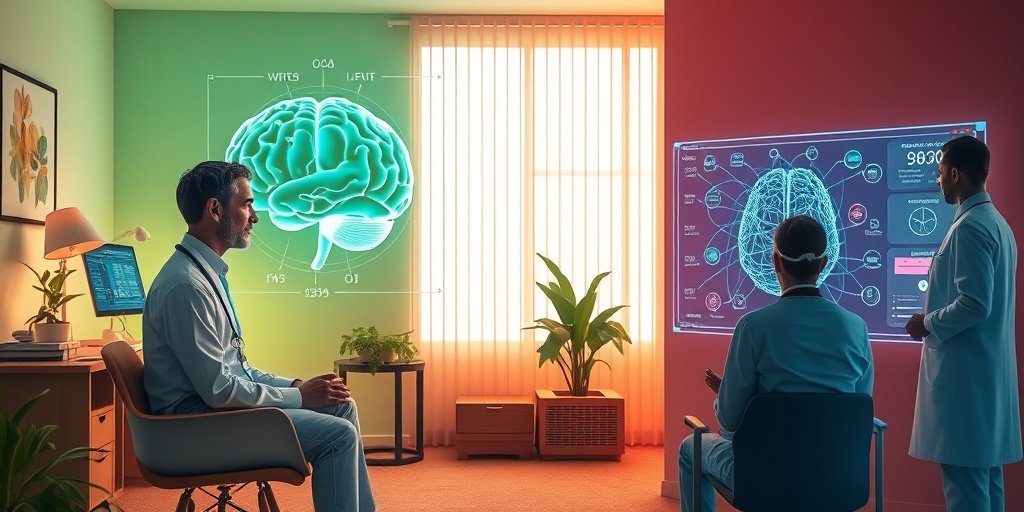⚡ Quick Summary
This study explores the integration of artificial intelligence in managing mental disorders through a comprehensive knowledge graph that connects over 3,000 entities. It highlights the potential for AI to enhance early detection, improve diagnostic accuracy, and facilitate individualized therapeutic interventions.
🔍 Key Details
- 📊 Dataset: 3,158 entities and 3,248 relationships
- 🧩 Technology: BioBERT pretrained language model
- ⚙️ Focus: Method-disease-data analytical axis
- 🏆 Applications: Early detection, diagnosis accuracy, individualized interventions
🔑 Key Takeaways
- 🤖 AI integration in mental health can lead to significant advancements in treatment management.
- 🧠 Knowledge graph developed to visualize relationships between AI methods, mental disorders, and data modalities.
- 🔍 Early detection of mental disorders is a key application of AI technologies.
- 📈 Improved diagnostic accuracy can be achieved through AI-driven approaches.
- 💡 Individualized therapeutic interventions are facilitated by AI insights.
- ⚠️ Challenges include imbalanced data sets, ethical issues, and concerns about trustworthiness.
- 🔄 Strategies proposed to address challenges in AI applications in mental health.
- 🌟 Future clinical applications are anticipated based on ongoing research and trials.

📚 Background
The intersection of artificial intelligence and mental health research has garnered increasing attention in recent years. While numerous studies have focused on specific aspects of AI applications, there has been a lack of holistic integration of these findings. This study aims to bridge that gap by systematically analyzing the relationships between AI technologies, mental disorders, and diverse data modalities.
🗒️ Study
The research utilized the BioBERT pretrained language model to extract relevant information and construct a comprehensive knowledge graph. This graph serves as a visual representation of the connections between various AI methods, mental disorders, and the data used in research, emphasizing the analytical axis of method-disease-data.
📈 Results
The knowledge graph developed in this study includes 3,158 entities and 3,248 relationships, providing a detailed overview of the landscape of AI applications in mental health. The findings underscore the potential of AI in enhancing early detection, improving diagnostic accuracy, and enabling individualized therapeutic interventions.
🌍 Impact and Implications
The implications of this research are profound. By leveraging AI technologies, we can significantly improve the management and treatment of mental disorders. The insights gained from this study pave the way for future clinical applications, potentially transforming how mental health issues are diagnosed and treated. However, it is crucial to address the challenges posed by data imbalances and ethical considerations to ensure the responsible use of AI in this sensitive field.
🔮 Conclusion
This study highlights the transformative potential of artificial intelligence in the realm of mental health. By integrating diverse data modalities and AI methodologies, we can enhance early detection, diagnostic accuracy, and personalized treatment approaches. As we move forward, it is essential to continue exploring these innovations while addressing the associated challenges to maximize their benefits for mental health care.
💬 Your comments
What are your thoughts on the integration of AI in mental health treatment? We would love to hear your insights! 💬 Leave your comments below or connect with us on social media:
Interaction of artificial intelligence, mental disorders, and diverse data modalities: Potential treatment management based on the “method-disease-data” axis.
Abstract
Although many previous studies have highlighted the advances in prediction models, instruments for pathological and histological diagnosis and treatment, as well as individualized treatment modalities in mental disorders, these previous syntheses usually study the research outcomes separately and ignore the holistic integration of research regarding artificial intelligence technological approaches, data sets used and applications in mental health research. We used the BioBERT pretrained language model to systematically extract relevant information and develop an extensive knowledge graph that includes 3158 entities connected with 3248 different relationships. Our knowledge graph delineates essential artificial intelligence technological frameworks and explicitly maps out the relationships linking artificial intelligence methods, mental disorders, and diverse data modalities. The synthesis, centered on the analytical axis of “method-disease-data,” highlights key research areas where artificial intelligence and neuropsychiatry meet. Specifically, it focuses on key applications in early detection, improved accuracy of diagnosis, and individualized therapeutic interventions. In addition, we summarized the applications derived from basic research findings that extend to ongoing clinical trials, revealing the path toward future clinical application in psychiatric work. Importantly, the research paid special attention to the application of artificial intelligence in identifying key brain regions and neural circuits, providing important clues for elucidating the neural mechanisms of mental disorders and developing targeted interventions. Although artificial intelligence presents great opportunities, there are also significant challenges, including imbalanced data sets, ethical issues, and clinical concerns about trustworthiness and transparency. Strategies to address these challenges are proposed, and a perspective on emerging methods enabled by artificial intelligence is provided, which are expected to greatly change the management and treatment of the future.
Author: [‘Tian X’, ‘Wang N’, ‘Yan J’, ‘Chen Y’, ‘Ma K’]
Journal: Neural Regen Res
Citation: Tian X, et al. Interaction of artificial intelligence, mental disorders, and diverse data modalities: Potential treatment management based on the “method-disease-data” axis. Interaction of artificial intelligence, mental disorders, and diverse data modalities: Potential treatment management based on the “method-disease-data” axis. 2025; (unknown volume):(unknown pages). doi: 10.4103/NRR.NRR-D-25-00121